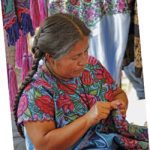Focus on Art
By Rob Mohr
Secrets of the Mature Artist

Want to create quality artworks? The process may not be as difficult as you think. Openness to learning and willingness to share understandings as well as to have your works critiqued within a community of artists will yield extraordinary results.
Art (creation) is a process. The resulting works are incidental. When the artist – curious and inquiring – learns to see with deep insight and to experience the world and life with feeling and emotion, the process becomes vital. A creative mind and spirit engendered by curiosity and profound insight give form to your emotions and then to your artworks. Awareness of the subtleties, nuances, the veiled aspects of reality, coupled with the capacity to work with these discoveries and experiences constitutes the way of the artist. A mature artist, with soul and spirit, becomes a revealer of emotions, architect of subversive signs, and a revealer of hidden truths.
Within the process of artistic maturation it becomes essential to look at and analyze the art of the past — of at least the last 200 years. Go to museums, use learning websites like the ones below, copy the artworks of great artists, and, with an open heart and mind analyze the artworks of your friends and associates. Read art journals, art history and Ralph Mayer’s essential The Artist Handbook.
www.metmuseum.org/explore/artists.asp
www.paintzion.com/ www.metmuseum.org/toah/
www.moma.org/learn/activities/index

Understanding the essential elements and principles that enable an artwork to hold together as one world or a whole must be understood and practiced. An artist needs to know the rules well before they break them – breaking the rules is how great art comes into being. Good paintings must somehow be aesthetically satisfying while they evoke raw emotion, touch the spiritual, or uncover memories, or shed light on mysteries. Good art always pushes viewers to new understanding of life and art and bring into being a new creation, or a new world never seen or understood before.
Successful art awakens, disturbs, pleases, lifts the viewer’s spirits, scares the hell out of us, and teaches in an unending variety of ways.
- April 2024 – Issue - March 31, 2024
- April 2024 – Articles - March 31, 2024
- April 2024 - March 31, 2024








